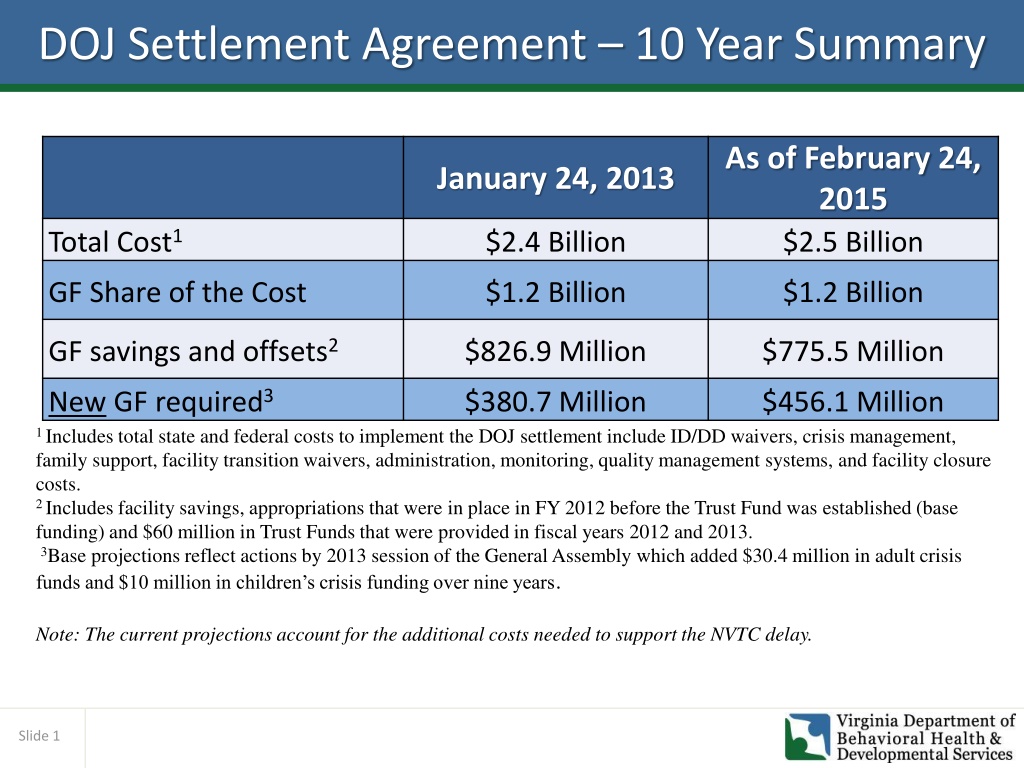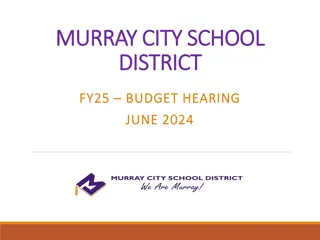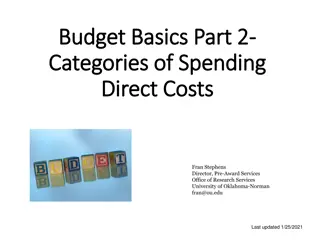DOJ Settlement Agreement 10-Year Summary
The DOJ settlement agreement as of February 24, 2015, outlines a total cost of $2.4 billion, with a $1.2 billion share from the General Fund. The agreement includes various costs such as waivers, crisis management, and facility transition. The funding need over ten years includes adjustments and new programs to support the settlement terms.
Download Presentation

Please find below an Image/Link to download the presentation.
The content on the website is provided AS IS for your information and personal use only. It may not be sold, licensed, or shared on other websites without obtaining consent from the author. Download presentation by click this link. If you encounter any issues during the download, it is possible that the publisher has removed the file from their server.
E N D
Presentation Transcript
DOJ Settlement Agreement 10 Year Summary As of February 24, 2015 $2.5 Billion January 24, 2013 Total Cost1 $2.4 Billion GF Share of the Cost $1.2 Billion $1.2 Billion GF savings and offsets2 $826.9 Million $775.5 Million New GF required3 1 Includes total state and federal costs to implement the DOJ settlement include ID/DD waivers, crisis management, family support, facility transition waivers, administration, monitoring, quality management systems, and facility closure costs. 2 Includes facility savings, appropriations that were in place in FY 2012 before the Trust Fund was established (base funding) and $60 million in Trust Funds that were provided in fiscal years 2012 and 2013. 3Base projections reflect actions by 2013 session of the General Assembly which added $30.4 million in adult crisis funds and $10 million in children s crisis funding over nine years. $380.7 Million $456.1 Million Note: The current projections account for the additional costs needed to support the NVTC delay. Slide 1
DOJ Funding Need over Ten Years DOJ Model Technical Adjustments 4% Itemized Variance ($75M) Funding Need over Ten Years $500 $75M variance (20%) $456.1 $450 $380.7 $400 Facility Discharge Delay 15% $350 New Programs 71% $300 Millions $250 Increased Waiver Costs 10% $200 $150 Housing Initiatives - $14M SIS Assessments - $12M DD Health Support Networks - $24M Bridge Funding - $3M $100 $50 $0 FY 2013 Projected New Funding Need Current Projected New Funding Need The ten year funding need is in part forecasted as there are still six years remaining in the Settlement Agreement. Slide 2
DOJ Funding & Expenditures 1 State match for waiver slots for those transitioning from the Training Centers to the community and for those on the community waiting list. Until the end of each fiscal year, DBHDS populates the line items with estimated accrued expenses based on average costs generated by DMAS. 2 Includes: one-time fund to provide and administer rental assistance to increase access to independent living options such as individuals own homes or apartments; capital subsidies for housing development; rent reserves; and transition supports. 3 Crisis stabilization programs offer a short-term alternative to institutionalization or hospitalization for individuals who need inpatient stabilization services. 4 Separation costs for Training Center employees, such as severance and retention bonuses. 5Required Independent Reviewer that reports to the federal judge on DBHDS compliance with the DOJ settlement. 6Expenses at DBHDS and DMAS that include licensing and Human Rights positions for community services oversight, and quality service reviews. 7 DBHDS funds some portion of the expense internally. 8 Direct and indirect savings realized from closing Training Centers. FY 2014 FY 2015 FY 2016 Actuals FY12 - FY16 Actuals through January 31, 2015 Actuals Budget Actuals Budget Budget Facility Transition ID Waivers1 Community ID & DD Waivers1 $19,534,660 $17,507,752 $27,754,467 $13,953,065 $36,048,306 $39,509,841 $27,642,275 $25,061,425 $28,828,547 $16,909,454 $40,554,370 $59,532,979 Individual Family & Support Housing2 Crisis Stabilization3 Facility Closure Costs4 Independent Review5 DBHDS Administration6 DMAS Administration6 Quality Management6 $3,800,000 $3,598,915 $3,398,000 $1,522,645 $3,200,000 $6,773,799 $800,000 $88,058 $5,227,000 $242,316 $0 $330,374 $12,231,711 $12,077,224 $12,239,000 $6,551,765 $16,250,000 $26,394,559 $7,690,099 $7,690,099 $27,998,679 $16,332,563 $22,606,966 $26,772,547 $328,000 $328,000 $360,000 $220,092 $379,000 $909,885 $1,807,338 $1,540,588 $2,098,000 $1,454,599 $1,888,000 $4,503,546 Data Not Available $787,000 $196,056 $739,360 $772,145 $196,056 $300,000 $155,010 $645,000 $83,928 $591,000 $398,397 Database Warehouse $956,000 $741,000 $925,000 $646,524 ($158,000) $1,387,524 Database Licensing $1,100,000 $0 $1,100,000 $0 $1,100,000 $0 Discharge Monitoring $138,000 $145,709 $400,000 $21,254 $140,000 $166,962 DMAS MMIS Community Provider Training7 Supports Intensity Scale7 $250,000 $250,000 $0 $0 $0 $250,000 $70,000 $25,782 $70,000 $91,858 $70,000 $117,640 $1,207,756 $765,953 $1,553,864 $624,972 $1,087,763 $1,390,924 DD Health Supports Network $0 $0 $2,000,000 $27,782 $2,600,000 $27,782 NVTC Bridge Funding $3,152,626 $0 $2,750,000 $289,208 $0 $289,208 Individuals Not Covered by Medicaid $0 $0 $31,450 $0 $125,801 $0 DBHDS Offset Facility Savings8 $0 $0 ($1,043,180) ($1,043,180) $0 ($1,043,180) * FY 2015 budget includes both conference actions and carry forward from FY 2014. ($19,364,535) ($16,315,271) ($41,448,095) ($24,178,055) ($54,684,954) ($46,065,315) Total (including base funding of $21.8M) $62,430,930 $53,856,299 $75,627,092 $33,750,789 $72,570,397 $121,843,528 Slide 3
DOJ Expenditure Variances Waivers Expenses are estimates until actual data is received from DMAS. Individual Family Support Program (IFSP) The IFSP application process has been broken into two cycles. The first cycle opened on September 15th resulting in 3,000 applications. Distribution of funds will began in mid-November. The second cycle starts in March. Housing FY 2015 budget includes several initiatives funded with carry forward funds from FY 2014. The initiatives consist of: Capital subsidy for two (2) four bedroom Group Home for eight Arlington County residents; HUD 811 Rent Reserve; Transition Support (HUD 811 and Rental Choice VA); Capital Subsidy for additional integrated housing development to assistance with the closure of NVTC; and Increased integrated housing opportunities in NOVA and to create options for integrated day activities. DBHDS Administration The department is reimbursed quarterly for the relevant Medicaid reimbursable positions. Slide 4
DOJ Expenditure Variances Licensing The current plan is to procure a Business Process Modeling vendor within the next two months to assess current state, benchmarking evaluation and proposed future state. The estimated cost for this is $90K $100K and the effort should be completed by March 2015. The department projects closing the fiscal year with a remaining balance in this category. Discharge Monitoring Options for fulfilling this objective were reviewed with the PMO Oversight Committee on November 21st. The Discharge Monitoring project will incorporate Referral Management at the request of the Regional Support Teams. The Discharge Planning component will be deployed to the Training Centers this spring The PMO is looking at opportunities to integrate this functionality with the planned Consolidated Waiver System. Bridge Funding There are many providers that have been approved funding that are not yet reflected in the expense data. Expenses are displayed once an invoice is received and paid. Slide 5
Amendments to current budget General Fund $s DMAS DOJ Amendments FY 2015 FY 2016 Adjusts the Medicaid appropriation for reimbursement for state training centers. This request reflects the Medicaid portion of the facility transition waivers, the on-going facility closure costs and associated facility savings. The funding estimates include facility transition waiver expenses, severance costs, post closure costs, pre-closure costs, and training center facility and Medicaid savings. This request results from the delay of discharges which impacts: savings, facility closure expenses and transition waiver costs. Total DMAS DOJ Amendments Rebase DOJ Related Expenses $535,369 $5,146,644 $535,369 $5,146,644 DBHDS DOJ Amendments FY 2015 FY 2016 Provides additional facility closure expenses for the delay in closing NVTC and for delayed discharges at state training centers. NVTC was originally slated to close at the end of fiscal year 2016. These reflect the cost to keep the facility operational. Increases the available funding for the Independent Reviewer assigned by the court to monitor the state's compliance with the settlement agreement. Facility Closure Expenses $0 $1,345,692 Independent Reviewer $0 $49,000 Quality Service Reviews Increases funding for quality service reviews necessary funds to contract for the provision of reviews. Provides funding to supplement funding for individuals not covered by Medicaid currently residing in state operated training centers to transition into the community. There are currently five identified individuals that may need funding in order to transition. Total DBHDS DOJ Amendments $0 $91,000 Supports for Individuals Not Covered by Medicaid $31,450 $125,801 $31,450 $1,611,493 Slide 6
Amendments to current budget General Fund $s DBHDS Waiver Redesign Amendments FY 2015 FY 2016 Provides funding to create a new and consolidated system for managing the intellectual and developmental disability waivers. The system will include wait list and waiver enrollment management as well as incorporate a citizen portal that will allow individuals to view waiver eligibility options, apply for waivers online, and identify licensed service providers. Total DBHDS Waiver Redesign Amendments Consolidated Waiver IT System $0 $453,888 $0 $453,888 Additionally, the Conferees added $8.2 million general fund within DMAS to support waiver service rate increases, utilizing captured savings of $7.8 million general fund from a technical correction related to community I/DD waivers. Waiver rate increases were proposed for the following services: Congregate Residential (except sponsored placement), In-Home Residential; Day Support and Prevocational Services, Therapeutic Consultation, Skilled Nursing and EPSDT Nursing. Slide 7
Conference Actions Training Center Language Conferees include language which directs the Joint Subcommittee to: Monitor and review the closure plans for the three remaining training centers scheduled to close by 2020. Review detailed information from the department including cost information and analysis of training centers on a quarter basis (starting October 20, 2015). Consider options for individuals in the training centers with the most intensive medical and behavioral needs as wells as the plans for waiver redesign. Slide 8
Conference Actions Waiting List Language Conferees incorporate language which directs DBHDS to: Work with Community Service Boards to report available information on the services and support needs of individuals on the I/DD waiting lists by December 1, 2015. Estimate the number of graduates with I/DD who are exiting secondary education each fiscal year. This information will be used to allow the Commonwealth to better understand the needs of individuals on the waiting lists and more accurately establish enrollment priorities, project services costs, and develop capacity needed to serve such individuals. Slide 9
Conference Actions Waiver Redesign Language Within DMAS, the conferees include language which directs DMAS, in collaboration with DBHDS, to: Provide a report by November 1, 2015, to include plans for the list of services to be included in each waiver, service limitations, provider qualifications, proposed licensing regulatory changes, proposed changes to rate structure for services, and cost to implement the changes. Include in the report the number of individuals currently served by the waivers as well as level of service need. Conferees incorporate language which directs DBHDS to: Include stakeholders from the acquired brain injury community in their redesign process of the Medicaid waivers for individuals with I/DD. Slide 10























